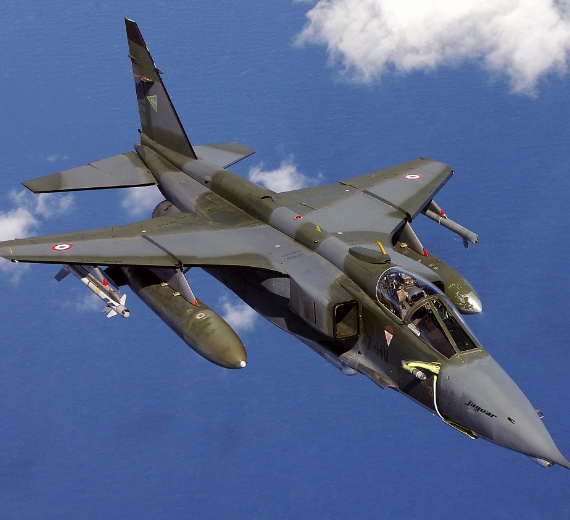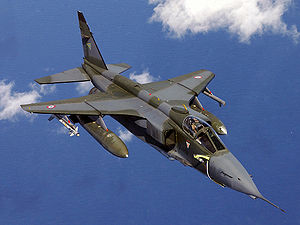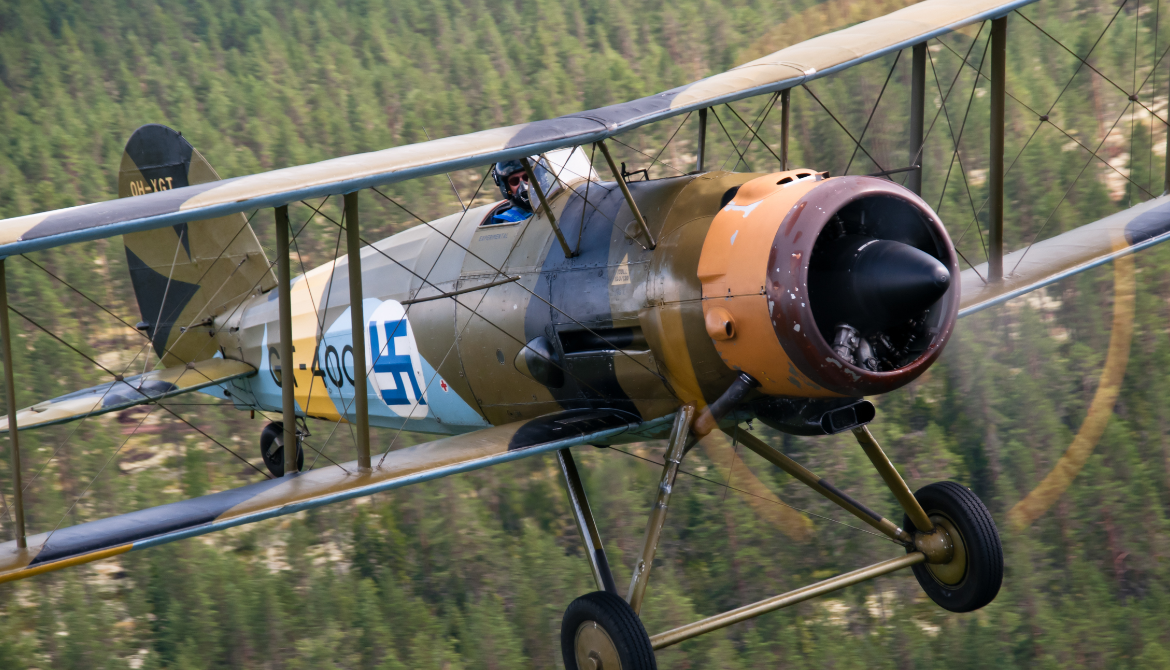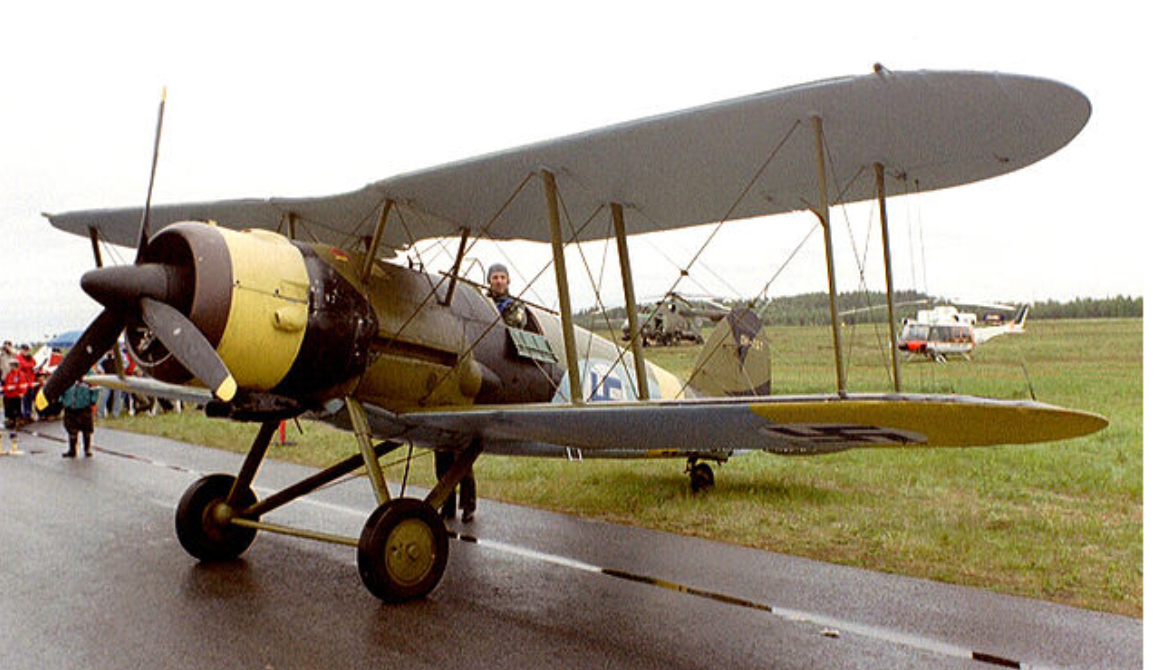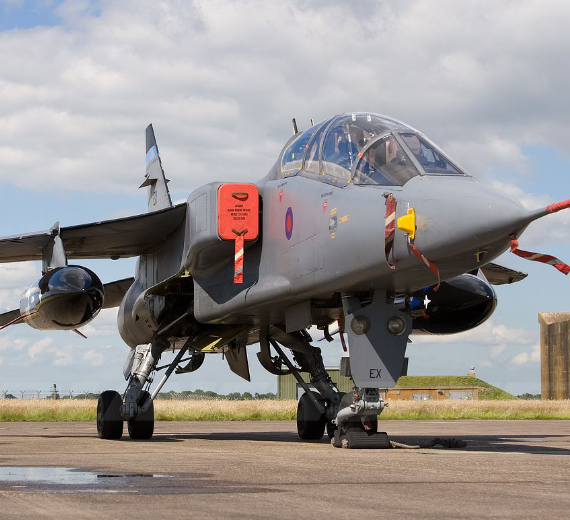SEPECAT/Bréguet Aviation SEPECAT Jaguar Gr.3
|
|||||||||||||||||||||||||||
|
|
|---|
.
History SEPECAT/Bréguet Aviation
SEPECAT Jaguar Gr.3

The Jaguar programme began in the early 1960s, in response to a British requirement (Air Staff Target 362) for an advanced supersonic jet trainer to replace the Folland Gnat T1 and Hawker Hunter T7, and a French requirement (the École de Combat et d'Appui Tactique, ECAT "tactical combat support trainer") for a cheap, subsonic dual role trainer and light attack aircraft to replace the Fouga Magister, Lockheed T-33 and Dassault Mystère IV. In both countries several companies tendered designs: BAC, Hunting, Hawker Siddeley and Folland in Britain; Breguet, Potez, Sud-Aviation, Nord, and Dassault from France. A Memorandum of Understanding was signed in May 1965 for the two countries to develop two aircraft, a trainer based on the ECAT, and the larger AFVG (Anglo-French Variable Geometry)
The SEPECAT Jaguar is an Anglo-French supersonic jet attack aircraft originally used by the British Royal Air Force and the French Air Force in the close air support and nuclear strike role. It is still in service with the Indian Air Force.
Variants

-
Design
Overview

RAF Jaguar GR3 with view of overwing AIM-9L Sidewinder missile. The Jaguar is an orthodox single-seat, swept-wing, twin-engine monoplane design, with tall tricycle-type retractable landing gear. In its original configuration, it had a maximum take-off weight in the 15 tonne class; with a combat radius on internal fuel of 850 km (530 mi), giving the Jaguar a greater operational range than competitor aircraft such as the Mikoyan MiG-27. The aircraft had hardpoints fitted for an external weapons load of up to 10,000 lb (4,500 kg). Typical weapons fitted included the Matra LR.F2 rocket pod, BAP 100-mm bombs, Martel AS.37 anti-radar missiles, AIM-9 Sidewinder missiles, and Rockeye cluster bombs. The RAF's Jaguars gained several new weapons during the Gulf War, including CRV7 high-velocity rockets and American CBU-87 cluster bombs. Finally, the Jaguar was equipped with either a pair of 30 mm autocannon - the French DEFA cannon, or British ADEN cannon.
The Jaguar International had the unusual option of overwing pylons, used for short-range air-to-air missiles, such as the Matra R550 Magic or the Sidewinder. This option freed up the under-wing pylons for other weapons and stores. RAF Jaguars gained overwing pylons in the buildup to Operation Granby in 1990, but French Jaguars were not modified
Photo Gallery
SEPECAT/Bréguet Aviation
SEPECAT Jaguar Gr.3


SEPECAT/Bréguet Aviation
SEPECAT Jaguar Gr.3
General Info 1
-
-
- Crew: 1 (A and S); 2 (B and E)
- Length: 16.83 m (55 ft 3 in)
- Wingspan: 8.69 m (28 ft 6 in)
- Height: 4.89 m (16 ft 1 in)
- Wing area: 24.18 m2 (260.3 sq ft)
-
General Info 2
-
-
- Empty weight: 7,000 kg typical, (dependent on variant and role)
- Gross weight: 10,954 kg (24,149 lb) full internal fuel and 120 rpg
- Max takeoff weight: 15,700 kg (34,613 lb) with external stores
- Fuel capacity: 4,200 L (1,100 US gal; 920 imp gal) internal, with provision for three 1,200 L (320 US gal; 260 imp gal) drop tanks on inboard and centreline pylons
- Powerplant: 2 × Rolls-Royce Turbomeca Adour Mk.102
-
General Info 3
- Maximum speed: 1,350 km/h (840 mph, 730 kn) Mach 1.1 at sea level
-
-
-
- 1,699 km/h (1,056 mph; 917 kn) Mach 1.6 at 11,000 m (36,000 ft)
-
-
- Combat range: 815 km (506 mi, 440 nmi) hi-lo-hi (internal fuel)
-
-
-
- 575 km (357 mi; 310 nmi) lo-lo-lo (internal fuel)
-
-
- Ferry range: 1,902 km (1,182 mi, 1,027 nmi) with full internal and external tanks
- Service ceiling: 14,000 m (46,000 ft)
- g limits: +8.6 (ultimate load +12)
General Info 4
-
-
- Guns: 2× 30 mm (1.181 in) calibre DEFA cannon with up to 150 rounds/gun
- Hardpoints: 7 (4× under-wing, 2× over-wing and 1× centreline) with a capacity of 10,000 lb (4,500 kg)
-
.
Links to Youtube & Others
Following the Iraqi invasion of Kuwait, on 9 August 1990 the British government assigned an initial 12 Jaguar GR1A and 12 Tornado F3 aircraft to the Middle East in Operation Granby.
SEPECAT/Bac/Bréguet SEPECAT Jaguar Gr.3
The airplane was the Gloster-Whittle E.28/39, registration W4041/G, the first of two prototype fighters powered by a turbojet engine.
Youtube Link
On 25 May 1935, the first two aircraft were delivered to No. 19 Squadron, while 20 of the first 24 Gauntlets had been completed by the end of the following month,
